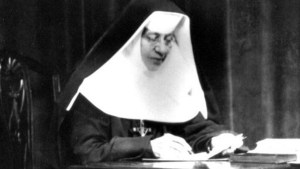Fabiola, the patron saint of divorced people, became a fashionable name thanks to the novel by Cardinal Wiseman, Fabiola; or, the Church of the Catacombs (1854), which recounts the conversion of a proud, haughty, and cruel patrician woman at the time of Diocletian’s persecution. In fact, while there is a St. Fabiola on the calendar, celebrated on December 27, she has nothing to do with the famous heroine of the novel—except for her first name and a life that was not very edifying at first.
Wife of a perfect scoundrel
The real Fabiola was born in Rome, probably at the end of the 340s or the beginning of the 350s, into one of the great families of the Roman aristocracy, the gens Fabia, who had given generals, consuls and many great men to the Empire. The Fabii, like the majority of patricians, converted to Christianity when, after the Edict of Milan in 313, Constantine no longer hid his sympathy for the religion of his mother, Helena.
In fact, many of these conversions were opportunistic and didn’t lead to any real change of life. Fabiola, still very young, paid the price in the person of her husband. When she reached marriageable age, her parents married her to a man of their milieu: rich, young, and even attractive—and Christian, at least in name. But, as Fabiola soon learned, this handsome and wealthy husband was a perfect scoundrel. A drunkard, gambler, and philanderer, he never ceased to cheat on her publicly, without even hiding it. Worse still, very early on he started to beat her.
Fabiola endured these abuses and humiliations with all the pride of women of her rank and birth, trying to conceal what she was enduring. One day, when she was about 18 years old, she realized that it was useless and that she had, for a long time already, been the laughing stock of the whole city and of her husband’s mistresses. In a burst of pride—probably because at this date, her parents died and she entered in possession of the family fortune, which assured her the means of her independence—she decided that enough was enough, and that she wouldn’t support this life one day more. She asked for a divorce.
Facing the consequences
Under Roman law, women could ask for a divorce as well as men, especially in cases of adultery and abuse. She obtained the divorce without difficulty. The Church had no objection; it never demands that a battered and scorned woman remain in the company of an unworthy husband. Only remarriage—which, with the spouse alive, is equivalent to adultery—was forbidden. Fabiola knew it well, and undoubtedly she was planning, at first, to respect the law of the Lord. What she couldn’t foresee was that a few months after her divorce, she’d meet a wonderful man. He was handsome, kind, tender, and caring, and she fell madly in love.
In such a case, as she was aware, some Christian women, including consecrated “virgins,” made dubious little “arrangements” in their minds. In order to continue to attend services and receive the sacraments, they pretended to live an exemplary life, receiving their lovers at night and as discreetly as possible. Young Fabiola was incapable of that kind of hypocrisy, which even revolted her. Plus, she wanted to display her love in broad daylight, whatever the consequences. So, Fabiola remarried under secular law, with her eyes open to what would come next. The sanction was immediate: excommunication.
Proud and disdainful, Fabiola abandoned the practice of religion and lived her passionate love with her beloved—at least, until the unfortunate day when, after only a few short years of happiness, her beloved husband died prematurely under tragic circumstances. Fabiola’s world collapsed. Not only did she lose the one she cherished more than anything else, but, shattered with anguish and remorse, she thought that because of her folly, her husband was in hell for eternity: an unbearable thought.
Redeeming her husband’s soul
By putting an end to the sinful situation in which she was living, her widowhood allowed her to claim her reintegration into the Church. It’s true, she’d have to do the penances that the early Church inflicted on great sinners. But, how could she redeem her husband’s soul?
For months, Rome watched in amazement as Fabiola, with her head shaved and covered in ashes, dressed in ragged clothing, came to kneel at the threshold of churches she was forbidden to enter and begged for prayers for herself and her poor husband. Emaciated from fasting and pale from tears, she was unrecognizable.
Finally, one day before Easter, finalizing her public humiliation, the young woman went to the church of St. John Lateran, threw herself at the knees of Pope Siricius, and publicly confessed her faults. Touched, the pontiff lifted all sanctions and reinstated Fabiola in the Church. Starting then, she lived an austere widowhood. She left her home only to go to the hospital, which she founded with her fortune and where she spent her entire day — the first hospital ever built in Rome and in Europe. The haughty patrician of yesteryear was caring for sick pilgrims, dressing the most horrible wounds, and—in an act of charity considered heroic, to which very few consented because it seemed so repugnant—she buried the dead. She offered all these sacrifices to God for the salvation of her husband’s soul.
Disciple of Jerome
Her only other regular outing was to the home of a noble widow, Marcella, where pious Christian women of the aristocracy gathered to pray together, to reflect on their role as mothers, and to exchange advice regarding the education of their children.
It was to this circle that a young priest named Jerome arrived in 383 after returning from a long stay in the East. Pope Damasus had entrusted him with the mission of re-translating the sacred texts. Moved by the piety of these women and astonished by their intelligence and thirst for learning, Jerome taught them Greek and Hebrew, initiated them into exegesis, and led them, now as their very demanding spiritual director, along the path of perfection.
In 394, Jerome was chased out of Rome, the victim of a jealous cabal and of his own rather abrupt outspokenness. He found refuge together with one of his spiritual daughters, Paula, in Bethlehem. There, they founded together a monastery for men and another one for women.
Fabiola made the trip to the Holy Land and considered taking the veil. Her intention was thwarted by the threat of an invasion by the Huns, which forced Fabiola to return to Rome as a precaution. There, while continuing her life of charity and penance, she held on to the dream of joining the convent in Judea. She was about to return when, on December 27, 399, she died suddenly. Rome gave her a triumphal funeral.


